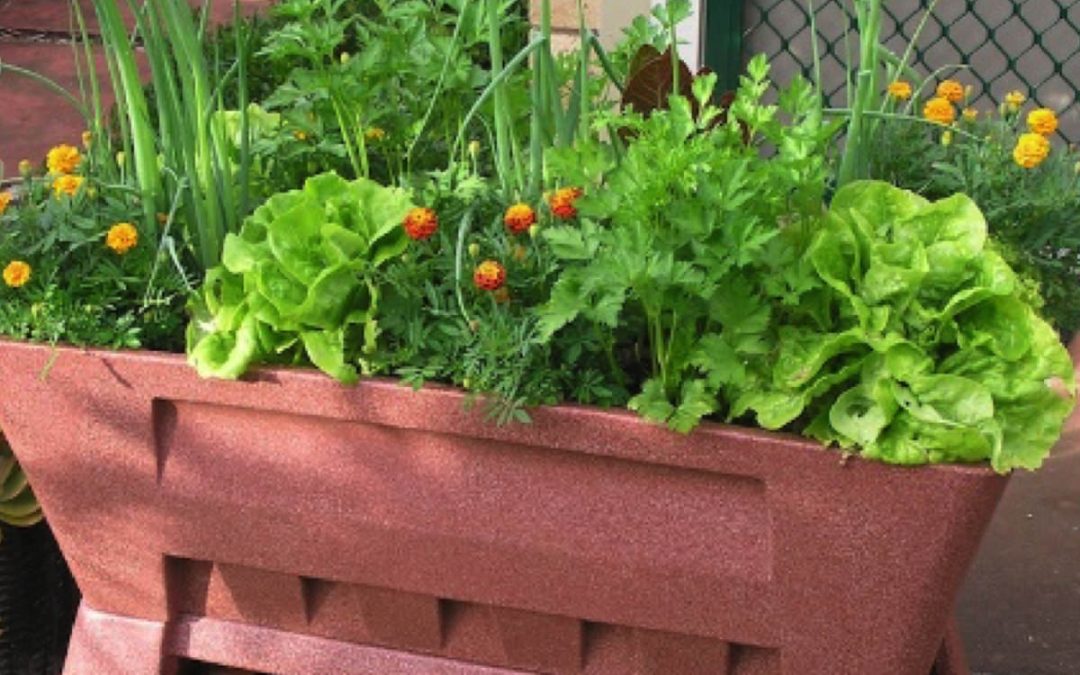
Varieties for Container Planting
More and more homeowners are enjoying growing their own vegetables. For many people, if they don’t have the room for a large garden, growing in containers is the answer! A container can be as small as a 6” pot (for a single basil plant), or as large as a 4’x8’ raise bed (a full salad garden). The trick is to match the container to the size your plants will need when they are fully mature, not when you first plant them! Choose a location for your containers where they will receive at least 6 hours of continuous direct sunlight. They can be on casters to move around as needed during the season. Remember the bees! Some of these vegetables (cucumbers, squashes and pumpkins especially) must be pollinated to produce fruit. To attract the bees to your containers, consider adding a few flowers.
Many varieties are “bush” or dwarf sized when mature or were bred for container production. Here are a few that you can grow from seed that stand up well in confined spaces but still produce a sizable harvest:

- Root vegetables: Beets, Carrots, Radishes & Onions. All do great in containers. If you plant too many at first, thin them, and eat your thinnings!
- Bush Beans (green, yellow or purple). Pole beans can be grown in containers with support for the vines.
- Cucumbers: Bush Pickle or Spacemaster. Again, vining cucumbers can be grown in pots with support.
- Eggplant: Bella Stripe or Melody. Even larger eggplants do well in containers but need sturdy support (short tomato cage) as they produce fruit.
- Kales: Dwarf Blue, Red or White Russian
- Lettuces: Tom Thumb, Little Gem or mixed leaf lettuces.
- Mesclun Salad Mixes. Seed them heavy and eat your thinnings.
- Tatsoi Scarlet Red and Boy Choi
- Peas: Sugar Ann or Sugar Daddy (tall peas can be grown in containers with support for the vines)
- Peppers (hot): Black Pearl, Ciliegia Piccante, Fish, Ghost, Hot Cherie, Habaneros, Jalapenos, Mad Hatter, Thai Hot, Large Red Cherry, Stromboli. Most hot peppers can be grown in containers with a little support
- Peppers (sweet): Alma Paprika, Medusa, Sweet Banana, Pimento, Roo. Most sweet peppers can be grown in containers with a support like a small tomato cage.
- Pumpkins: Black Kat, Casperita, Orangita, Scream II. These all grow short 2’ vines, but the container should be large (15 gal min) to accommodate the needed root mass to produce good pumpkins.
- Spinach: Oceanside
- Squash (summer): Mabel, Bush Scallop, Mayo, Sligo, Butta, King Zuk, San Pasquale, Zippy, Ziti
- Squash (winter): Bush Delicata, Poppasquash Acorn Swiss Chard: El Dorado (yellow) or Rainbow Mix

- Tomatoes: Patio, Sunny Boy, Mountain Spring, Siberian, Marinara, Roma, Baby Cakes Cherry, Tiny Tim Cherry. Even larger tomato plants can be grown in containers if the container is large enough to support their root system and some sturdy support for the plant once it starts to produce fruit (min 5gal pot).
- Herbs: Arugula, Dwarf Greek Basil, Spicy Globe Basil, Siam Queen Basil, Catnip, Chives, Santo Cilantro, Bouquet or Dukat Dill, Savory, Greek Oregano, and Parsley. Rosemary also does well in containers but would have to be brought inside for the winter.
- Strawberries: Formosa (day-neutral type that bare all season)
- Add a few dwarf flowers and you have a mixed combo of color and texture: Alyssum, Pinocchio Dwarf Aster, Sea Shell Cosmos, Garden Pride Dahlia, Dwarf Goblin Gaillardia, Signet Marigolds (edible flower), Nasturtiums (another edible flower), Music Box Sunflowers, Zahara Series Zinnias.

Containers come in all different sizes, colors and shapes. Use a single pot for one plant or a larger container for a mixture. An old whiskey barrel makes a great salad container; it can hold one container sized tomato plant, one bush cucumber plant, 6 leaf lettuces, 6 carrots or radishes (replanted when harvested), 4 spicy globe basil plants and one parsley plant. Or try growing in milk crates with a liner (burlap or a grow bag). Here’s a link to a How-To article: https://www.neseed.com/square-foot-garden-in-milk-crates

There are lots of container growing ‘kits’ available from Earth Boxes (self-watering) to Grow Bags. Be creative with your containers. An old suitcase or boot. A bathtub. An old cracked pot or basket. A strawberry jar filled with herbs (or strawberries). Old rain gutters. An old wheel barrel, an old bed frame or the ultimate moveable garden – a truck bed!
Use good quality bagged soil-less mix for your containers; not soil from your garden. Most contain at least some fertilizer, but you will have to feed your container garden regularly throughout the season. For ease, you can use a time-release fertilizer or one that you add to the water. Your containers will need more water as the plants mature as well. Larger pots will need watering less often; smaller ones may need to be watered daily (or even twice a day).
There are also great sources for container ‘recipes’ on the internet, the Master Gardener’s extension service or books at your local library.
